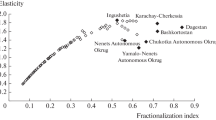Abstract
This paper analyzes the existing relationship between ethnic fractionalization, corruption and the growth rate of a country. We provide a simple theoretical model. We show that a nonlinear relationship between fractionalization and corruption exists: corruption is high in homogeneous or very fragmented countries, but low where fractionalization is intermediate. In fact, when ethnic diversity is intermediate, constituencies act as a check and balance device to limit ethnically-based corruption. Consequently, the relationship between fractionalization and growth rate is also non-linear: growth is high in the middle range of ethnic diversity, low in homogeneous or very fragmented countries.
Similar content being viewed by others
References
Acemoglu D, Verdier T (1998) Property rights, corruption and the allocation of talent: a general equilibrium approach. Econ J 108: 1381–1403
Acemoglu D, Verdier T (2000) The choice between market failures and corruption. Am Econ Rev 90(1): 194–211
Alesina A, Drazen A (1991) Why are stabilizations delayed. Am Econ Rev 81(5): 1170–1188
Alesina A, La Ferrara E (2005) Ethnic diversity and economic performance. J Econ Lit 43: 762–800
Alesina A, Spolaore E (1997) On the number and size of nations. Q J Econ 112(4): 1027–1056
Alesina A, Baqir R, Easterly W (1999) Public goods and ethnic divisions. Q J Econ 114(4): 1243–1284
Alesina A, Devlseschawuer A, Easterly W, Kurlat S, Wacziarg R (2003) Fractionalization. J Econ Growth 8(2): 155–194
Allport GW (1954) The nature of prejudice. Beacon Press, Boston
Atlas Narodov Mira (1964) Moscow: Glavnoe upravlenie geodezii i cartografii
Bellini F, Rosazza Gianin E (2008) On Haezendonck risk measures. J Banking Finance 32(6): 986–994
Benchekroun H, Withagen C (2010) The optimal depletion of exhaustible resources: a complete characterization. Cahiers de recherche 04-2010, Centre interuniversitaire de recherche en économie quantitative, CIREQ
Bhattacharyya S, Hodler R (2010) Natural resources, democracy and corruption. Eur Econ Rev 54(4): 608–621
Blackburn K, Bose N, HM Emranul (2010) Endogenous corruption in economic development. J Econ Stud 37(1): 4–25
Boucekkine R, Ruiz-Tamarit J (2008) Special functions of the study of economics dynamics: the case of the Lucas-Uzawa model. J Math Econ 44: 33–54
Boucekkine R, Martinez B, Ruiz-Tamarit J (2008) Global dynamics and imbalance effects in the Lucas-Uzawa model. Int J Econ Theory 4(4): 503–518
Collier P (2001) Implications of ethnic diversity. Econ Policy 32(16): 127–166
Corneo G (2010) Nationalism, cognitive ability, and interpersonal relations. Int Rev Econ 57: 19–41
Dobson S, Ramlogan-Dobson C (2010) Is there a trade-off between income inequality and corruption? Evidence from Latin America. Econ Lett 107(2): 102–104
Drugov M (2010) Competition in bureaucracy and corruption. J Dev Econ 92(2): 107–114
Easterly W, Levine R (1997) Africa’s growth tragedy: policies and ethnic divisions. Q J Econ 112(4): 1203–1250
Evrensel AY (2010) Corruption, growth, and growth volatility. Int Rev Econ Finance 19(3): 501–514
Fisman R, Gatti R (2002) Decentralization and corruption: evidence across countries. J Public Econ 83(3): 325–345
Goovaerts MJ, Kaas R, Dhaene J, Tang Q (2004) Some new classes of consistent risk measures. Insur: Math Econ 34(3): 505–516
Haezendonck J, Goovaerts M (1982) A new premium calculation principle based on Orlicz norms. Insur: Math Econ 1(1): 41–53
Krasnoselskii MA, Rutitsky YB (1961) Convex function and Orlicz spaces. P. Noordhoff, Groningen
Lambsdorff JG (1998) An empirical investigation of bribery in international trade. Eur J Dev Res 10: 40–59
La Porta R, Lopes de Silanes F, Shleifer A, Vishny R (1999) The quality of government. J Law Econ Organ 15(1): 222–279
Lessmann C, Markwardt G (2010) One size fits all? Decentralization, corruption, and the monitoring of bureaucrats. World Dev 38(4): 631–646
Li H, Xu CL, Zou H (2000) Corruption, income distribution and growth. Econ Polit 12(2): 155–182
Mauro P (1995) Corruption and growth. Q J Econ 110: 681–712
Mauro P (1997) The effects of corruption on growth, investment, and government expenditure: a cross-country analysis. In: Elliot KA (ed) Corruption in the global economy. Institute for International Economics, Washington
Musila JW, Siguè SP (2010) Corruption and international trade: an empirical investigation of African Countries. World Econ 33(1): 129–146
Ortega J, Tångeras TP (2008) Unilingual versus bilingual education: a political economy analysis. J Eur Econ Assoc 6(5): 1078–1108
Rose-Ackerman S (1999) Corruption and government. Cambridge University Press, Cambridge
Schmidt KD (1989) Positive homogeneity and multiplicativity of premium principles on positive risks. Insur: Math Econ 8(4): 315–319
Shleifer A, Vishny R (1993) Corruption. Q J Econ 108(3): 599–617
Svensson J (2000) Foreign aid and rent-seeking. J Int Econ 51: 437–461
Tajfel H, Turner JC (1986) The social identity theory of inter-group behavior. In: Worchel S, Austin LW (eds) Psychology of intergroup relations. Nelson-Hall, Chicago
Tajfel H, Billig M, Bundy RP, Flament C (1971) Social categorization and intergroup behavior. Eur J Soc Psychol 1: 149–178
Tångeras TP, Lagerlöf NP (2009) Ethnic diversity, civil war and redistribution. Scand J Econ 111(1): 1–27
Treisman D (2000) The causes of corruption: a cross-national study. J Public Econ 76(3): 399–457
Vicente PC (2010) Does oil corrupt? Evidence from a natural experiment in West Africa. J Dev Econ 92(1): 28–38
Wrong M (2009) It’s our turn to eat: the story of a Kenyan Whistle-Blower. Harper, New York
Yoo SH (2008) Petty corruption. Econ Theory 37: 267–280
Author information
Authors and Affiliations
Corresponding author
Rights and permissions
About this article
Cite this article
Cerqueti, R., Coppier, R. & Piga, G. Corruption, growth and ethnic fractionalization: a theoretical model. J Econ 106, 153–181 (2012). https://doi.org/10.1007/s00712-011-0253-5
Received:
Accepted:
Published:
Issue Date:
DOI: https://doi.org/10.1007/s00712-011-0253-5




